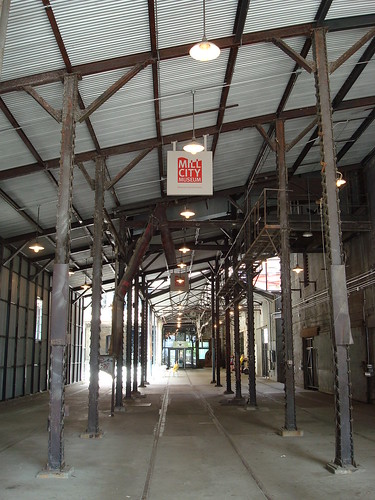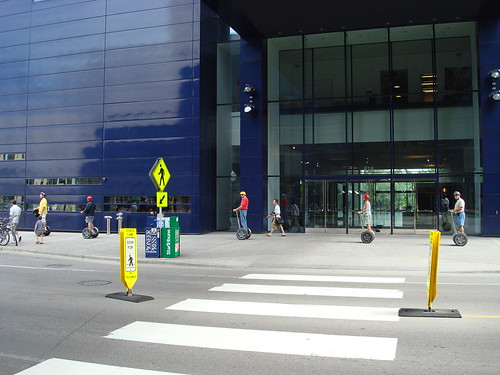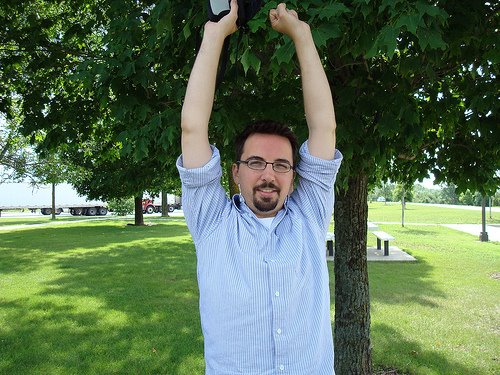Wednesday, August 27, 2008
Making the History of 1989
Great new website with primary sources, first hand accounts, and teaching strategies from the Centre for History and New Media. Check out Making the History of 1989 if you are teaching about the Cold War this year.
Tuesday, August 26, 2008
Political Junkie
I admit in my spare time I'm a pretty heavy political junkie. And I love the New York Times website for interactive and interesting online features. I will let you explore them on your own but the one I wanted to point out for History Teachers is a timeline of Democratic Conventions (I assume/hope the Republican one is on the way).
In one small presentation you could teach an entire class on the politics, economics, and social aspects of the United States since 1948. I found the 1956 convention in Chicago particularly interesting and wanted to point out Adlai Stevenson's speech at the end. How things have changed along the way.
In one small presentation you could teach an entire class on the politics, economics, and social aspects of the United States since 1948. I found the 1956 convention in Chicago particularly interesting and wanted to point out Adlai Stevenson's speech at the end. How things have changed along the way.
Tuesday, August 12, 2008
Vocabulary of the Blog
The other day I came across an interesting program called Wordle. The site grabs your RSS feed and turns it into a word mosaic - making most used words larger. So of course I checked my own blog and created the following:
 What I actually found most interesting was the way it emphasized my apparently limited vocabulary on the blog. With words such as great, fun, and really jumping out - I actually got an unfortunately clear view of my writing (I'm blaming it all on emailing).
What I actually found most interesting was the way it emphasized my apparently limited vocabulary on the blog. With words such as great, fun, and really jumping out - I actually got an unfortunately clear view of my writing (I'm blaming it all on emailing).
I thought a really interesting project with your students would be to take their work - even all of their essays - dump them into a blog on blogger, and then run them through Wordle to see what words come up most. The exercise should improve vocabulary and also be a bit of ... (anything fun) unbridled enthusiasm....? I'm trying anyways.
You could also do this as a class project to see what vocabulary words in general your students use most.
 What I actually found most interesting was the way it emphasized my apparently limited vocabulary on the blog. With words such as great, fun, and really jumping out - I actually got an unfortunately clear view of my writing (I'm blaming it all on emailing).
What I actually found most interesting was the way it emphasized my apparently limited vocabulary on the blog. With words such as great, fun, and really jumping out - I actually got an unfortunately clear view of my writing (I'm blaming it all on emailing).I thought a really interesting project with your students would be to take their work - even all of their essays - dump them into a blog on blogger, and then run them through Wordle to see what words come up most. The exercise should improve vocabulary and also be a bit of ... (anything fun) unbridled enthusiasm....? I'm trying anyways.
You could also do this as a class project to see what vocabulary words in general your students use most.
Thursday, August 07, 2008
10 Photos that Changed Canada
The Beaver magazine today is launching a special feature today called the 10 photos that changed Canada. It's a great feature about some of the definitive images that have shaped Canada. The article is available in the August/September 2008 issue of the magazine.
I wanted to point it out because not only is it a fun feature, but we also have several podcast interviews that I thought were particularly interesting this month. Ray Argyle talks about meeting Robert Mallandaine, who is looking over Donald Smith's shoulder as he pounds home the last spike - arguably Canada's most famous photo.

For anyone who can follow along, there is also a great interview in French with Robert Nadon, the photographer who captured the image of Pierre Laporte's body in the trunk of a car during the October Crisis.
And finally, you can also hear Ric Ernst discuss how the judges narrowed down their list of iconic images.
I wanted to point it out because not only is it a fun feature, but we also have several podcast interviews that I thought were particularly interesting this month. Ray Argyle talks about meeting Robert Mallandaine, who is looking over Donald Smith's shoulder as he pounds home the last spike - arguably Canada's most famous photo.

For anyone who can follow along, there is also a great interview in French with Robert Nadon, the photographer who captured the image of Pierre Laporte's body in the trunk of a car during the October Crisis.
And finally, you can also hear Ric Ernst discuss how the judges narrowed down their list of iconic images.
Wednesday, August 06, 2008
History of America Tour: Magical History Tour
Just outside of the Mill City Museum we were delighted to see the Magical History Tour passing in front of The Guthrie Theatre.
Now since I've gotten back apparently there are Segway history tours in a lot of cities. But I still thought it was a really fun way to get around. If we had more time I definitely would have gone for a spin - sort of kicking myself now that I didn't.
Labels:
Magical History Tour,
Minneapolis,
Segway,
The Guthrie
Tuesday, August 05, 2008
History of America Tour: The Mill City Museum

About a week ago I ventured down into the heart of America down to the great state of Kansas. Along the way I we stopped at a number of historic sites and museums. It was a fun chance not only to visit some new place and learn a bit of history, but to see some new and original projects.
One of the first stops along the way was in Minneapolis, Minnesota. Minneapolis is actually a terrific city with a surprising amount of things happening (sorry Minneapolis we had low expectations going in). It's got great art galleries, theaters, and of course, museums. We stopped at the Mill City Museum in the downtown.
Now the history of flour milling might not sound all that exciting, but there are definitely some great projects happening here. The Museum itself is built into the preserved ruins of the Washburn A Mill. Aside from being a great piece of architecture and preservation, they offer an excellent and smart little history of the city in 19 minutes that is quite well done.
But most impressive is the Flour Tower. Rather than producing a regular exhibit with displays set in place, they moved the exhibit into the former grain elevator. You step on and ride the elevator between floors, where the doors open into each display area. The story follows all parts of the milling process and is narrated with first hand accounts of what it was like to work in the factory as you travel between floors.
It's a terrific way to take an otherwise quite static exhibit and make it engaging and interesting.
Subscribe to:
Comments (Atom)







